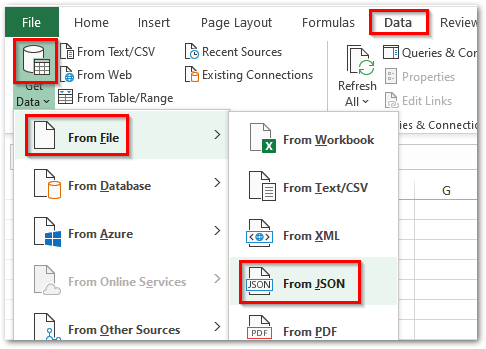

So, when working with big data in Gigasheet, you do not have to write a single line of code or set up a database. Gigasheet is a no-code big data worksheet. Gigasheet, by default, supports ZIP format, so you can directly upload compressed JSON files without having to un-compress them first. Select Excel as a source app, connect your Microsoft account, and select the workbook and worksheet to pull JSON data to. Configure the connection to the JSON API and the query using the optional parameters. Often JSON files are too large, and users compress them to ZIP format to save storage. Specify the JSON URL to import data from. Gigasheet, on the other hand, has no such constraints so you can process large multi-gigabyte JSON files. Gigasheet allows you to upload files from different sources - local storage or the cloud storage services like Google Drive, Dropbox, SFTP, and AWS S3.Įven though MS Excel is easily accessible on modern PCs, it cannot process more than 1,048,576 rows of data. JSON data is not transforming into proper table. But after getting data in excel, trying to transform that JSON data into Table by using power query. There are some other very significant advantages of using Gigasheet over other options.įirst of all, Gigasheet is a web application that you can access from the web browser on your PC, laptop, and even a mobile device. Hi, Actually i am getting data from external source through API by using 'From Web' option in excel & getting JSON data. The cookie is used to store the user consent for the cookies in the category 'Analytics'. The video shows how to quickly create a new Contact Collection by uploading an Excel document.Comparing the processes above shows that using Gigasheet to convert JSON to CSV for Excel is much easier than the other two, especially if the file is large or if you aren't intimately familiar with the data structure. Cookie Duration Description cookielawinfo-checkbox-analytics: 11 months: This cookie is set by GDPR Cookie Consent plugin. Then, select All Filetypes and you should be able to open the JSON file. Another fix can be by clicking From Text instead of From JSON. In our demo database, we have a Projects collection. After Query Edit opens, you have to right-click a document icon on a query dashboard and select JSON and your data will now be transformed to a table data format. The first JSON document is used to "guess" the data type for the rest.

The data must be a valid array of JSON documents.

You can also create new Collections from JSON. name= text, address= text, email= email and age= number. The example table above, the second row with data is used to "guess" the data type for columns in all rows.Į.g.


 0 kommentar(er)
0 kommentar(er)
